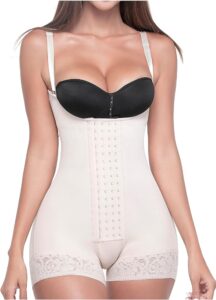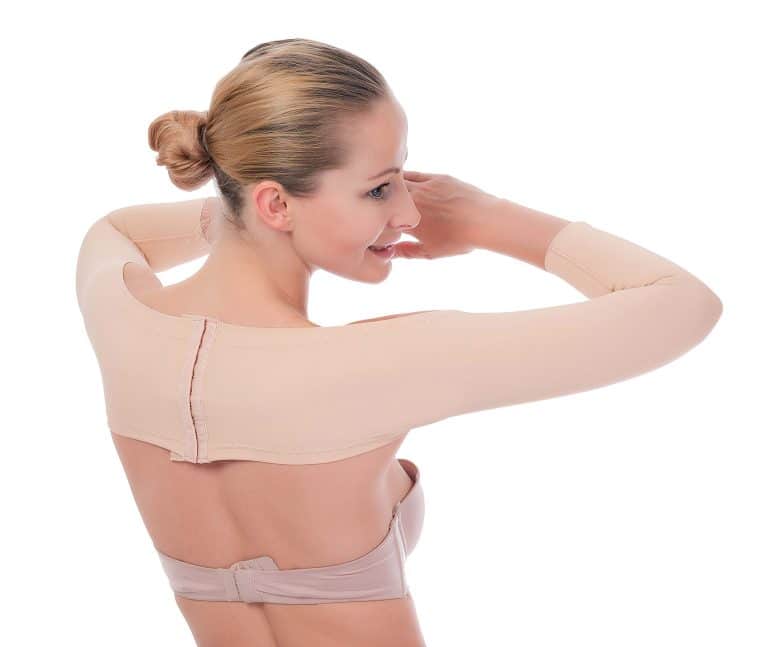Key Takeaways
-
We know that timing is key in the post-operative recovery. Outwearing compression garments early on can be a huge factor in healing and avoiding further complications.
-
Early application of compression garments after surgery facilitates fluid evacuation and contributes to better control of swelling.
-
Early and regular use of compression garments aids in skin retraction, contouring, and promotes optimum aesthetic results.
-
Using the garment according to a staged timeline—from immediate post-surgery to long-term maintenance—provides the best possible recovery.
-
Compression garments help minimize swelling, increase circulation, and support tissue healing, all of which play a major role in ensuring a more comfortable recovery.
-
Choosing the most effective garment requires thoughtful consideration of material, fit, and working with healthcare providers to help customize choices based on individual surgical needs.
Knowing when to wear a post-operative garment will set you up for a positive recovery experience. These garments, fitted, firm and comfortable, are critical for that healing. After surgery, they’re essential for managing swelling and healing.
Each of these stages has different compression requirements and they serve a different purpose. I think about my own recovery journey and how the timing was just perfect indeed. We know you have more questions about these magical garments and we’re here to help you uncover them.
They assist your body in healing and maximizing results. Here’s a closer look at how timing and these recovery garments can go hand-in-hand for optimal post-workout recovery.
Why Timing Matters
Impact on Recovery
When it comes to timing after surgery, it’s essential for ensuring a great recovery, especially when wearing quality compression garments. These surgical garments aid in fluid drainage immediately following procedures like liposuction or tummy tuck surgery. This is crucial because the less swelling there is, the quicker the body can begin the healing process.
For example, the use of these compression garments for 20-23 hours per day is typically recommended during the acute post-operative phase. It’s like providing your body with a support system at home to better navigate the changes it’s experiencing after a cosmetic procedure. By tracking swelling levels, we can determine the effectiveness of these garments.
If the swelling decreases, good. Make sure you wear them as directed through the first 1-2 weeks to make sure your body has the best chance for an easy recovery. This is exactly when open drainage can happen, so it’s extremely important to prevent removing the garment.
Enhancing Surgical Outcomes
The early application of compression garments can dramatically enhance the cosmetic outcomes of surgery. When used appropriately, these garments also assist with skin retraction and contouring, thus improving the aesthetic result.
For others, this translates to wearing the piece nonstop for those first few weeks. Patients learn quickly that wearing a compression garment is a key component in achieving optimal results. They usually sign up to wear it for a few weeks, often 4-6.
Taking note of recovery milestones, including less swelling and a better skin contour, is important. This also includes garment utilization, which makes sure that the garments are worn when they are most beneficial.
Preventing Complications
Wearing the correct compression garments at the appropriate time in the post-operative process is important in preventing complications as well. Proper use of these garments minimizes the risk of complications including fluid build-up and over swelling.
Watch for warning signs of more serious problems. If you notice ongoing swelling or pain, it might be time to reevaluate your garment use. Set a schedule for donning these outfits.
For instance, transition to a second-stage medical-grade garment after 1 to 2 weeks when the drainage ceases to reduce the risk of postoperative complications. Surgeons are also advised to prescribe compression garments for 20 hours a day minimum.
It is a gentle and effective practice that honors and supports your body as it heals.
Stages of Wearing Compression
Initial Post-Surgery Stage
During that initial post-op period, it’s super important to be diligent about wearing first-stage compression garments. These ensembles are built to provide healing support and allow for the drainage of excess fluids, reducing potential bruising.
We find this stage lasts usually 1 to 2 weeks, and for this period patients are wearing these garments around the clock, including while they sleep. For large, invasive surgeries such as tummy tucks and body lifts, Dr. Beldholm advises his patients wear them for four weeks.
Keeping the surgical field clean and sterile is of utmost importance, making sure the garments do not bring in any contaminants. The garment’s compression action prevents swelling and enables healing.
Intermediate Healing Phase
At the end of the acute stage, when drainage has stopped, it’s time to move to second stage compression garments. This may be the most difficult stage, which can range from 2-8 weeks depending on the procedure and individual healing times.
These garments are specifically designed to help reactivate lymphatic function and minimize swelling even more. For more complicated procedures, a full six weeks is recommended.
Most importantly, regular use of these garments enhances the natural healing process of the body. Stay on the timeline as you have in the first phase. This will ensure you get the most out of your benefits and prevent you from losing the hard progress you’ve made.
Long-Term Maintenance
Following this intermediate phase, the attention needs to transition to long-term upkeep. Shapewear or everyday wear attire becomes the recovery wear plan.
These shapewear pieces should provide a great deal of comfort while maintaining a flat and sleek look, which leads to confidence and happiness with the outcome. The length of time and style of these garments should be addressed with their medical care team, since personal preferences and needs may vary greatly.
For less invasive surgeries, such as breast augmentation, wearing a surgical bra for four weeks is advised. This stage is all about keeping the recovery going and helping the body adjust to the new surgical changes.

Benefits of Compression Garments
After surgery, the benefits of compression garments are endless, improving physical appearance along with comfort. These garments not only decrease persistence and boost circulation, but they also offer an essential effect in protecting tissue recovery.
Here’s a closer look at these benefits:
-
Reduce swelling effectively
-
Promote better blood circulation
-
Support overall healing and recovery
-
Minimize acute postoperative pain and seroma incidence
-
Enhance quality of life post-surgery
-
Prevent complications like capsular contracture and hematoma
Reducing Swelling
Compression garments are key to controlling postoperative edema. For example, following a breast augmentation, they serve to reduce the effects of swelling and reduce risk for capsular contracture.
Frequent observation of swelling and modifications of garment tension maximize results. This method is additionally effective in decreasing swelling and increasing range of motion, especially post-ankle fracture surgical procedures.
Improving Circulation
These garments are specifically engineered to promote blood circulation, which is essential to a quick recovery. By increasing circulation, patients have less postoperative drainage and wound healing occurs more quickly than with traditional methods, particularly when used in conjunction with cryotherapy.
Applying techniques such as making sure it is a correct fit and comfortable can maximize return to activity very quickly. This method minimizes the chances of unsatisfactory garment fitting, estimated to fall anywhere between 4% and 44%.
Supporting Tissue Healing
Compression garments help repair tissues by exerting a continuous, even pressure which, in turn, helps control scar formation associated with burn injuries.
Using clothing designed for particular surgical zones, such as the groin post-hernia repairs, results in optimal healing. Recording progress is important for determining the effectiveness of compression therapy.
It can improve overall quality of life and decrease acute post-surgical pain.
How to Choose the Right Garment
Here’s what they say Choosing the right post-operative garment. Wisdom comes from knowing a few important facts that can greatly improve your recovery experience. It begins with understanding the role of compression garments, which should be customized to your unique surgical procedure.
Think about which part of your body was operated on, because each one needs different levels of support. For instance, surgeries on the abdomen may require garments with more compression than surgeries on the arms. Men, especially, want to look for breathable fabrics that keep him comfortable when going from work to play and everything in between.
TriFlex™ is one of the best examples of high-quality fabric delivering reliable all day support and comfort. Take into account your agility and mobility when deciding how you will fasten things. Fasteners such as zippers, hooks, and Velcro provide different degrees of convenience and safety.
Consider Material and Fit
Fabric choices matter. The fabric of your compression garment makes a significant difference in comfort as you heal. Choose fabrics that promote airflow and wick moisture away from the skin, which helps keep you dry and comfortable.
The fit is just as crucial; it needs to be firm yet not overly so. When a piece works with your body’s movements and rhythms, actively supporting you with confidence in every action, you feel comfortable all day, every day. Elastic materials frequently offer this blend, letting you flex and bend while still delivering the stiffness and stability you need.
Additionally, make sure that the garment doesn’t migrate or roll down while going about daily life, which can hinder recovery.
Consult with Healthcare Provider
Consulting with your healthcare provider is the key to choosing the appropriate garment. Hold planning meetings to determine which garments might work best for your surgery and situation. Your surgeon should be able to give you some guidance on what levels of compression you’ll need and assist you in ensuring proper sizing and quality.
Usually, they need to be worn fulltime for several weeks before going to part-time wear per instructions. Few surgeries may need just some weeks of compression. Others could need months.
Being able to wear these garments every day is essential, with numerous patients experiencing significant healing results in a matter of days.
Addressing Common Concerns
Patients routinely have misgivings and misconceptions surrounding the use of compression garments post-surgery. Others are concerned about how long they’ll have to wear masks or if they’ll be hot or uncomfortable.
Here are some common questions:
-
How tight should the garment be?
-
Will it be uncomfortable to wear all day?
-
How long will I need to wear it?
-
What if it irritates my skin?
Be assured that these queries are quite common. Wearing compression garments will speed your return to daily life. They make painful activities easier to do by reducing swelling and accelerating healing.
Doctors usually prescribe wearing them all day long, for most of the waking hours. During those first few weeks post surgery, that can be up to 20-23 hours!
Handling Discomfort
Changing the status quo is not without its discomfort. You may experience some pressure, but by changing the tightness you can find the perfect fit.
It’s really important to pay attention to your skin to avoid friction burn. Choosing hypoallergenic fabrics and getting the right fit also goes a long way.
If something doesn’t feel right, see if the article is pinching you or if the fabric is irritating against your body.
Understanding Duration of Use
When to wear compression garments The timing is different for everyone. For some procedures, a compression garment is needed for only 1-2 weeks post-op, while for others, a garment is needed for 4-6 weeks.
For larger surgeries such as tummy tucks, wearing a garment for 8-12 weeks is most helpful. Following these guidelines will help minimize bruising and bleeding, allowing your body to heal effectively.
Managing Skin Irritation
Skin irritation may develop, but it tends to be mild and controllable. Finding what might be irritating your skin, such as fabrics, is key to avoiding it.
Choose hypoallergenic materials and limit wear time as necessary. Be vigilant and look for any signs of skin irritation, and speak with your physician if changes need to be made.
Conclusion
Knowing when to expect post-op garments is a total recovery game-changer. From minimizing swelling to enhancing mobility comfort, each phase of compression wear comes with unique advantages. Dressing the part Selecting the right garment is like selecting the right shoe; it’s all about fit and function. Some of the most frequent objections and how to respond to them Putting yourself out there can be intimidating. More importantly, it’s valuable to have these realizations in your back pocket and draw on them as a compass to help navigate your road to recovery. The more informed choices you make, the faster you’ll be able to heal and the more you’ll improve your overall quality of life. In the face of this knowledge we encourage you to step into the process, assured that it takes time. As ever, listen to your body and seek guidance from your medical team for tailored recommendations. Become a member today to get exclusive tips and advice from experts! Encourage future participants with your tales and tactics from the journey you’ve already taken.
Frequently Asked Questions
What is the ideal timing for wearing post-operative compression garments?
Instruct patients to begin wearing quality compression garments as soon as possible post-op, under doctor’s orders. Most commonly, they are prescribed for a duration of 4-6 weeks. This extended timeline plays an important role in maximizing circulation and aiding the recovery process.
Why is timing crucial for post-operative garment use?
The right timing lets the body heal best, and using quality compression garments early and consistently decreases swelling, aiding in a quicker recovery time by supporting the injured tissues.
What are the stages of wearing compression garments?
Wear quality compression garments 24 hours a day, 7 days a week at first, except when showering. Once the recovery period is complete, perhaps only daytime use of the surgical garment would be necessary. Listen to your plastic surgeon’s advice and follow it.
What benefits do compression garments offer post-surgery?
Compression garments play a crucial role in decreasing inflammation, increasing blood flow, and assisting in body sculpting, ultimately aiding in achieving a quicker recovery after plastic surgery procedures.
How do I choose the right post-operative compression garment?
You want to look for comfort, fit, and material in quality compression garments. Ask your plastic surgeon which garments work best for your specific surgery and unique needs during the recovery process.
What if my compression garment feels uncomfortable?
Some initial discomfort is to be expected after the liposuction procedure. If pain continues, see your physician. Ensure the compression garment is snug but not too tight.
Can compression garments affect my surgical results?
Of course, if compression garments are misused, the impacts can be averted. Follow suggested timing to promote healing and optimize recovery from your liposuction procedure.





